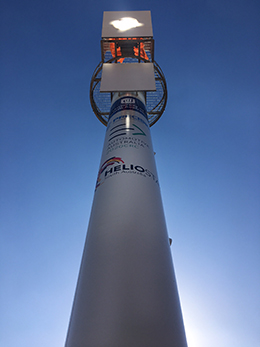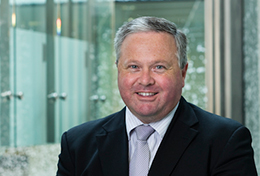10 October 2017
 When UniSA and Precision Component’s new Concentrated Solar Research Field is launched today at Edinburgh, it will be a perfect example of how industry and university collaboration can pave the way for the development of world-leading future industries in South Australia.
When UniSA and Precision Component’s new Concentrated Solar Research Field is launched today at Edinburgh, it will be a perfect example of how industry and university collaboration can pave the way for the development of world-leading future industries in South Australia.
The launch of the 25-heliostat field will be held today at 11.15 am at the Precision Component’s manufacturing facility, at Woomera Avenue, Edinburgh Parks.
The heliostats, each of 7.2 m2, and the 15 metre tall concentrated solar photo-voltaic receiver, generate about 30 kW of electricity per hour.
Heliostats concentrate sunlight onto a tower, and depending on the type of receiver unit, either heat or a variety of fluids can be used to generate steam to power turbines to generate electricity (as will be the case for the recently announced Port Augusta concentrated solar power development), or the sunlight can be converted directly into electricity using a high efficiency solar cell receiver, as used to power satellites in space.
This next generation solar power technology will be vital to the development of renewable power sources both here and internationally.
And it is the new ideas developed by UniSA researchers in partnership with industry, more than eight years ago to solve a car components problem, that have been a vital building block in this new project set to deliver advanced solar technology.
The heliostat innovations hope to deliver more reliable energy production, at a time when every improvement in renewable energy systems counts.
The heliostat testbed employs an innovation in thin film coating design, an application that evolved from the same research that delivered the world’s first fully plastic automotive mirror.
Lead researcher and Industry Professor at UniSA’s Future Industries Institute, Peter Murphy says the design challenges in developing a heliostat surface that can stand up to all the environment can deliver, echo some of the challenges in designing the car mirror.
“Heliostats need to withstand heat, cold, rain, UV light exposure and abrasion by sand, often in harsh, arid environments,” Prof Murphy says.
“To be really effective they must have a lifetime of 25 to 30 years and that presents a huge set of challenges at a macro and nano scale.”
Premier of South Australia, Jay Weatherill, says that the new site, and the important research and development work being undertaken in partnership with UniSA, shows South Australia’s leadership in the national transformation to renewable energy technologies.
“Working in partnership with Precision Components, a company previously servicing the automotive industry, the two companies demonstrate a successful diversification from a manufacturing skill base into other industry sectors,” Premier Weatherill says.
“There is huge potential for growth in SA’s renewables sector. Heliostat has an impressive plan to develop a $1.6million new tracking system that would create 33 construction and more than 90 ongoing jobs.”
Director of Precision Components, Mat Fitch says the development of the site is an important milestone for Precision Components.
“This is another significant step in the diversification strategy we implemented to safeguard the future of the business and to create employment opportunities for South Australians,” Fitch says.
“The relationship we have built with UniSA and the outcomes we have delivered are an exemplar for collaboration between the private sector and universities.”
 Prof Murphy says the completion of the research field marks the fruition of a short-term goal for the group.
Prof Murphy says the completion of the research field marks the fruition of a short-term goal for the group.
“Our goal now is to use this facility for R&D so that we can design and prototype a better heliostat and a system with remote wi-fi control,” he says.
“Our long term research goal is to develop tough, ultra-high reflectivity mirror coatings on polycarbonate to underpin lighter, more efficient heliostats that stay cleaner for longer.
“Being able to do this research in partnership with local industry and manufacturers is a real privilege.
“It is incredibly rewarding to see our research translated into real world outcomes.”
Background
- The key industry collaborators on the research field project are Precision Components and Heliostat SA.
- Heliostat SA designs and manufactures solar energy technologies for both the concentrated solar power and PV tracking industry sectors.
- Precision Component’s is a leading, South Australian-owned and located designer, manufacturer and supplier of specialised press metal, fabricated components and assembly solutions to a range of industries, including the renewables sector and defence.
Media contact: Michèle Nardelli mobile 0418 823 673 email michele.nardelli@unisa.edu.au




